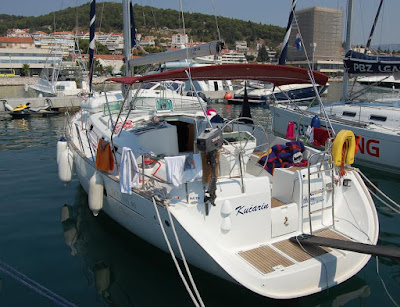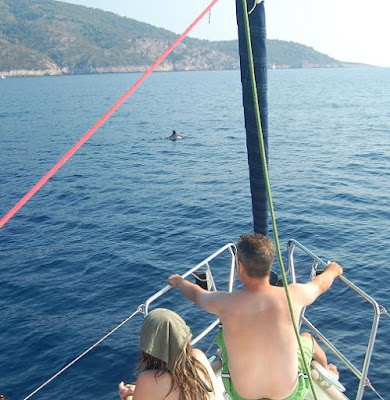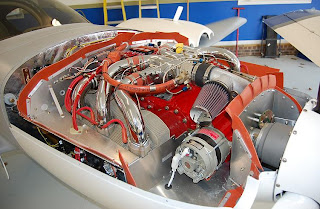
Day 1 – Split
Our group convened at the Split airport where we tried to keep our driver from leaving before all eight of us were in the van. During peak vacation time (read: July and August) this little airport is overcrowded with holiday-makers from all over Europe, meaning there is no room to park (hence our driver wanted to leave) and little room on the tarmac for airplanes (which is why our last crew-member was still circling the skies above us.) The rest of the ride to the marina was uneventful until the last 500 meters, which although being a two-way road, was only one lane wide. This meant that at nearly every attempt our driver made, he could never make it to the halfway point or otherwise force the oncoming traffic to back up (incidentally, I had the same experience driving in Sofia the following week.)
 This first day we did not even cast off lines; the afternoon was spent provisioning (which entailed pushing grocery carts full of food for over 1 km), briefing, and familiarization for our boat, an Océanis 411 called the Kučarin (pronounced “Koochareen”.) In the evening, we took a water taxi to the old town, which was interesting, but I didn’t want to spend too much time there as I was still trying to catch up the sleep I had recently missed.
This first day we did not even cast off lines; the afternoon was spent provisioning (which entailed pushing grocery carts full of food for over 1 km), briefing, and familiarization for our boat, an Océanis 411 called the Kučarin (pronounced “Koochareen”.) In the evening, we took a water taxi to the old town, which was interesting, but I didn’t want to spend too much time there as I was still trying to catch up the sleep I had recently missed.Day 2 – Split to Brač Island
It seems none of my crew-members are morning people, so generally we got underway around 10 or 11 every day. After tacking back and forth into the wind most of the afternoon, we decided that Brač Island was far enough, and anchored in a secluded yet crowded cove that featured two primitive, outdoor restaurants (where we would eat that evening.)
The funniest thing to happen this day occurred as we were trying to anchor. On the stern of a neighboring boat there were two completely naked, young women (we assume they were German) frolicking in the water; in fact, one of them got on a pool raft and briefly got in our way as we were laying down the anchor chain. If only I had my camera at hand (and not been busy at the windlass,) I would have photographic proof of this distraction for you now. ;-)
Mirena was happy to be back on solid ground again, so we hiked over the hill to the little, sea-side town of Milna, which was pleasant but unremarkable by Dalmatian standards as we would find out later in the week; every town, village, and burg on these islands is an idyllic, old fishing village.
Day 3 – Sail to Vis
We left our little cove on Brač and sailed most of the day on a single, south-westerly tack in moderate winds to the island of Vis. Here we found Komiža, the town, harbour, and pebbled beach where we anchored, and which would later be the cause of all our problems.

Although it was almost evening, some of us swam a little bit before getting ready for dinner, as tonight turned out to be “date night” and each couple found their own restaurant in Komiža. Our group (including David, Marta, Mirena, and myself) returned to the boat first, even after traipsing all over this little town and having dinner. David and I were sitting in the cockpit watching our boat and others being blown around by the strengthening “bora” winds that were coming off the mountains in front of us and wondering if we were getting closer to the anchor buoy of the boat behind us. You have to understand that a boat will move a little in wind and waves even when anchored securely—which is, of course, disconcerting.
We did indeed lose anchorage, and David and I were forced to haul up the anchor (partly manually because the windlass circuit breaker kept tripping.) At the same time, Mike and the rest of our crew attempted to reach us with the dingy (by now we had drifted almost 1 km downwind.) Eventually we got the anchor up and motored back into the harbour where Mike had found a British guy on a similar sailing yacht who helped us out and showed us how to how to rig two anchors in series, which he said should be good for winds up to 100 knots! This being done, I felt secure and went to get some shut-eye, while the rest of the crew stayed up nervously monitoring our movement in the still increasing “bora” winds.
I guess it was an hour later when I was awoken, told to put on a life vest, and assist on deck as our anchorage had either failed or been pulled up by another nearby boat’s failed anchorage. The skies were dark, the winds were howling, and other boats whose anchorage had also failed were motoring about the harbour seemingly not knowing what to do. Mike was at the helm trying to avoid other boats and make it easier for David and Ken to manually crank the anchor chain back up (the tension on the chain prevented us from using the windlass for more than a few second before the breaker would trip—which was Melinda’s job to reset, since the breaker was in her cabin; we later joked that we would call her up unexpectedly at night and tell her “reset the breaker” just so she could relive this exciting time!) We suspected that our anchor had become entangled with another boat’s anchor (specifically the British guy who had helped us earlier,) and that indeed became apparent as we reeled in the final 10m of chain. Imagine the scene: 2 boat, each over 40 feet long, attached bow-to-bow, spinning slowly around each other as if in an lumbering dance, as we both slowly reeled in our anchors. We finally got the first anchor up, and David heroically leaned over the bow railing to untangle our friend's anchor chain—we were finally free! Disgusted with our experience in Vis, we intended to sail through the night to our next destination. This turned out to be foolhardy in these less-than-ideal conditions, so we head back and anchored closer to shore. This third anchorage was successful, and the rest of the night (what little was left) was uneventful.
Day 4 – Blue Grotto, Vela Luka
In the morning, we were able to pull into one of the coveted marina slips in Vis to refill our totally empty fresh water tanks. Had this slip been available the previous evening, we would have been well rested, and not had any of the adventures of the previous night. We had a long day of sailing planned, but decided that we had to see the famous “Blue Grotto” on Biševo Island. This is a sea cave with a fairly large chamber and two openings: one long, narrow opening that can be negotiated by a dingy, and another short one that is underwater, and gives the chamber its namesake blue hue. It took two trips for everyone to see it, but was definitely worth it.


The rest of the afternoon was spent sailing almost directly downwind in heavy seas; this was both fun/satisfying (we hit 9 knots) and—for the ladies—a little disconcerting since the boat would pitch and roll in every direction as 2 meter waves would overtake us from the stern.
We originally intended to sail to Korčula Town, but—as the light was waning—decided to pull into Vela Luka on the near side of the same island. Vela Luka was indeed a great harbour as its name suggests, but it is not the renowned fortress town of Korčula we wanted see. Never the less, we had a nice meal and managed to catch a folk dance exhibition in the town square.

Day 5 – Lumbarda, Korčula
The next morning we immediately set sail—well, after Mike got his requisite cappuccino—for Korčula. We arrived in the early afternoon only to find that the marina was full. Continuing on to the next little town, Lumbarda, we found that their slips were also either occupied or reserved. We had promised ourselves that, at this halfway point, we would treat ourselves to a marina, where we could get a real shower, shore power to recharge phones/cameras, and not have to be ferried to/from shore by dingy every time. For this reason, Mike became very persistent—circling our boat in front of the marina’s docks until they agreed to let us “just refill our water tanks.” With this foot-in-the-door, our crew was eventually able to secure us the slip for the night.

Day 6 – Korčula to Mljet
Unlike previous days, we planned to stay on this island for most of the day. Most of us rented scooters to get to Korčula town and explore the rest of the island. Mirena and I set off eastward on a road that followed the coast and revealed all the little coves and idyllic sea-side towns along the way—one of which we would stop for lunch, and have one of the best meals of the trip. Despite being an under-powered scooter, Mirena insisted I was driving too fast, so I let her drive, and—by the end of the day—she had become quite competent at negotiating a scooter with two people on it over narrow, twisting roads.



By 19:00 we were all back on board and ready to sail on to Mljet—an island comprised mainly of national park. We had planned this to be the evening that we would eat onboard instead of going to a restaurant, and preparations were going on below deck as we
Day 7 – Mljet, Lopud, Dubrovnik marina
This final day of sailing was going to be a long one; we needed to cover the remaining distance to Dubrovnik, since we were now a day behind schedule. Still, we made a beer stop, a stop for swimming, and stopped on Lopud for dinner. As we were finishing up our Prošek, a stiff wind blew into town, and we knew that we needed to get back on the boat quickly in order to continue down the coast to Dubrovnik and hopefully outrun the approaching storm—which we did. Although it was night, and there was lightning flashing across the sky behind us, we were reassured to see the lights of Dubrovnik in the distance. Soon enough we were under the Tuđman Bridge, and aside from one final incident, found ourselves safely berthed at ACI Marina for our final night on the Kučarin.

Day 8 – Dubrovnik
We had to leave the boat by 9:00 (which of course dragged out another hour plus,) and our flight back to Vienna left at 15:00. This meant we could only hit the highlights in Dubrovnik—which is an amazing city, and deserves a lot more time. Along with Marta, whose flight was also leaving around the same time, we made our best effort to see as much of the Stari Grad (old town) as possible in one afternoon. Unfortunately, after 813 photos, the battery on my camera ran out, so here is a picture taken with Mirena’s camera phone.

Evaluation: This was my third sailing trip, and probably my favourite. Last year I sailed in Turkey (also with Mike) and the Caribbean with my family. What the Dalmatian Coast lacks in sandy beaches and coral reefs, it more than makes up for in its ports of call. Being the Mediterranean coast, it reminded me a lot of Turkey, but what was missing in Turkey was the living sense of history that is pervasive in Croatia. Both countries have undergone conflicts in recent history, but—although Croatia’s war was just a decade ago—it has been all patched up and its towns have a sense of timelessness more like those in Italy or Spain.
Mirena prefers snorkeling in warm Caribbean waters and missed having a sandy beach, but back on land—aside from the natural beauty (which is sometimes hard to find)—the Caribbean simply lacks the millennia of civilization that is infused throughout the entire perimeter of the Mediterranean Sea. I am convinced that a day poking around the shore anywhere in this, the hub of ancient trade would yield at least a shard of antique pottery. And, as students of western civilization, many of the stories we already know took place in this region; the island of Mljet, for example, is a more probable location of the apostle Paul’s shipwreck than the traditional site of Malta, and Homer’s Odysseus is also rumored to have visited this island.
 Notes on pronunciation: Serbo-Croatian, which despite protestations from Mirena and Marta, is indeed is the common language of Serbia, Bosnia, and Croatia—each have their own dialect that they insist is a separate language. On the Dalmatian Coast, and especially farther north in Istria, this language is spoken with a distinctly Italian cadence; without listening to the words, (many of which are recognizable to Bulgarian speakers) I could have sworn they were speaking a Romance language.
Notes on pronunciation: Serbo-Croatian, which despite protestations from Mirena and Marta, is indeed is the common language of Serbia, Bosnia, and Croatia—each have their own dialect that they insist is a separate language. On the Dalmatian Coast, and especially farther north in Istria, this language is spoken with a distinctly Italian cadence; without listening to the words, (many of which are recognizable to Bulgarian speakers) I could have sworn they were speaking a Romance language. What really throws most people off though, is the elimination of the vowel “uh” in writing (both in the Latin and Cyrillic alphabets,) so if you see too many consonants in a row, throw an “uh” in there (especially before an “r”) to make it pronounceable. On this subject, you must read this humorous take that I originally thought Dave Barry wrote, but can't seem to find an attribution: Operation Vowel Drop
Pronounce most of the letter as you would expect with these exceptions: J is soft (“y”) like in German, C is always ‘ts’ as in Cincinnati, Č is ‘ch’, Š is ‘sh’, Ž is usually written ‘zh’ and pronounced like the ‘s’ in “measure”, Đ is our ‘j’; vowels—of course—are European: A=‘ah’, E=‘eh’, I=‘ee’, O=‘oh’, U=‘oo’...oh, and roll your R!




















